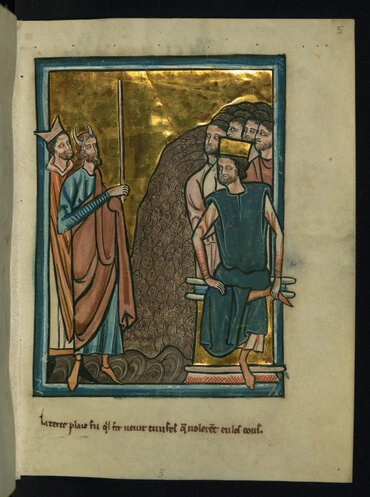40
Las cortinas del atrio, y sus columnas, y sus basas, y el pabellón para la puerta del atrio, y sus cuerdas, y sus estacas, y todos los vasos del servicio del tabernáculo, del tabernáculo del testimonio;
40
Las cortinas del atrio, y sus columnas, y sus basas, y el pabellón para la puerta del atrio, y sus cuerdas, y sus estacas, y todos los vasos del servicio del tabernáculo, del tabernáculo del testimonio;
1186. And no craftsman of whatsoever craft shall be found in thee any more, signifies no more wisdom, intelligence, or knowledge. This is evident from the signification of "craftsman of whatsoever craft," as being everything belonging to the understanding, consequently wisdom, intelligence, and knowledge, for these belong to the understanding, the inmost of which is wisdom, the middle intelligence, and the lowest is knowledge. This is the signification of "craftsman of whatsoever craft," because these are endowments of the understanding, and its endowments are signified by "crafts." As these are signified by "crafts," so in the Word where the construction of the tabernacle is treated of, also the garments of Aaron, which were of gold, blue, purple, scarlet double-dyed, and fine twined linen, it is said that they were to be the work of the "craftsman," elsewhere "a work of a contriver" (Exodus 26:1, 31; 28:6; 39:8; and elsewhere). The things of which these were made, and which are here mentioned, signify things of wisdom, intelligence, and knowledge; therefore of Bezaleel and Oholiab, who were the craftsmen, and who made these things, it is said:
They were filled with wisdom, intelligence, and knowledge (Exodus 31:3; 36:1-2).
[2] That "craftsman" signifies intelligence from what is one's own [proprium] is evident in Hosea:
They make them a molten image of their silver, and idols in their intelligence, all of it the work of the craftsmen (Hosea 13:2).
"Molten image" and "idol" signify worship according to doctrine that is from self-intelligence; "silver" signifies the falsity from which such doctrine comes; therefore it is said "that in their intelligence they make them an idol, all of it the work of craftsmen." So in Isaiah:
The craftsman melteth a graven image, and the goldsmith spreadeth it over with gold, and casteth chains of silver; he seeketh a wise craftsman (Isaiah 40:19-20).
And in Jeremiah:
Silver spread into plates is brought from Tarshish, and gold from Uphaz, the work of the craftsman and of the hands of the founder, hyacinthine and garments, all of it the work of the wise (Jeremiah 10:3, 9).
Here and in many passages elsewhere self-intelligence is described by "idols," and "sculptured and molten images" (See n. 587, 827).
(Continuation)
[3] End, mediate causes, and effect, are called also the chief end, intermediate ends, and the final end. Intermediate and final ends are called ends, because the chief end produces them, is everything in them, is their esse and is their soul. The chief end is the will's love in man, the intermediate ends are subordinate loves, and the final end is the love of the will existing as it were in its effigy. As the chief end is the love of the will it follows that intermediate ends, being subordinate loves, are foreseen, provided, and produced through the understanding, and that the final end is the use foreseen, provided, and produced by the love of the will through the understanding, for everything that love produces is a use. This must be premised in order that what has just been said may be perceived, namely, that eminence and riches may be blessings or that they may be curses.

8, 9...fue inaugurado en el cargo de sumo sacerdote de Israel. En ese papel, Aarón representa al Señor en cuanto al Bien Divino, y Moisés representa al Señor en cuanto a la Verdad Divina. Aarón era el hermano de Moisés. Él simboliza dos cosas, una durante la primera parte del éxodo, cuando era el portavoz de Moisés, y otra después de que se construyera el Tabernáculo y fuera inaugurado como sumo sacerdote. En la primera parte de la historia, Moisés representa la Palabra tal como es en realidad, tal como se entiende en el cielo, y Aarón representa la Palabra en su sentido externo tal como es entendida en el mundo por las personas. Por eso habla en nombre de Moisés y el Señor dice de él "será como una boca para ti, y tú serás para él como Dios". (Éxodo 4:16).
(Odkazy: Arcana Coelestia 6998, Arcana Coelestia 9806, Arcana Coelestia 9936, 10397; Éxodo 4:14, 28:1, 32:1; Levítico 8, 9)